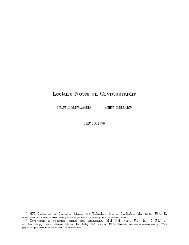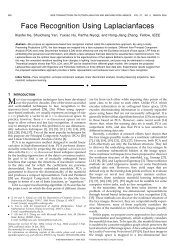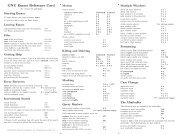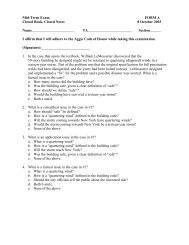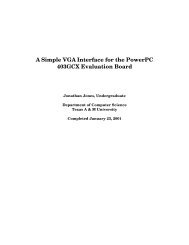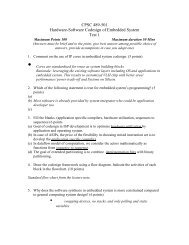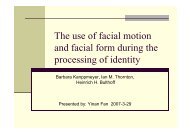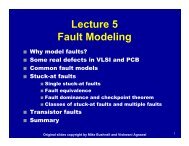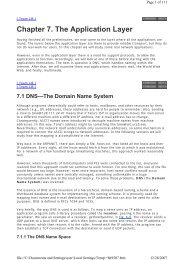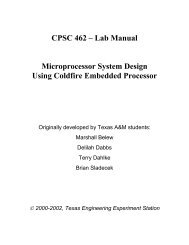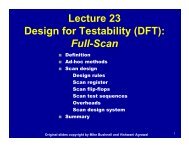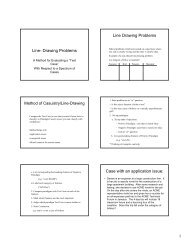Download - CS Course Webpages
Download - CS Course Webpages
Download - CS Course Webpages
Create successful ePaper yourself
Turn your PDF publications into a flip-book with our unique Google optimized e-Paper software.
Winter 2002, <strong>CS</strong> 790<br />
Introduction to Pattern Recognition<br />
Homework #2<br />
Due date: 2/11<br />
In recognition of the Wright State University policies of academic integrity, I certify that I have<br />
neither given nor received dishonest aid in this homework assignment.<br />
Name: ______________________________ Signature: _____________________________<br />
NOTES:<br />
1. Start each problem on a separate page<br />
2. Provide hardcopies of all plots, MATLAB code and derivations.<br />
3. <strong>Download</strong> the compressed file ‘hw2.zip’ from the course web page<br />
4. Sign and return this page with your finished assignment.<br />
Problem 1 (10%)<br />
In a two-class, three dimensional classification problem, the feature vectors in each class are<br />
normally distributed with covariance matrix<br />
0.25<br />
Σ =<br />
<br />
<br />
0<br />
<br />
0<br />
0<br />
0.25<br />
0<br />
0 <br />
0<br />
0.25<br />
The respective mean vectors are [ 0 0 0] T<br />
and [ 1 1 1] T<br />
. Assume that p(ω<br />
2<br />
) = 2 ⋅ p(ω1)<br />
.<br />
Derive the corresponding linear discriminant functions and the equation describing the<br />
decision surface. Use this decision surface to classify the example [ 0.1 0.7 0.8] T<br />
.<br />
Problem 2 (10%)<br />
Generate 200 examples for each of the three densities:<br />
µ<br />
Σ<br />
1<br />
1<br />
T<br />
T<br />
[ 1 3 3] µ = [ 4 0 3] µ = [ 0 - 4 0]<br />
=<br />
3<br />
=<br />
<br />
<br />
2<br />
<br />
− 1.9<br />
2<br />
3<br />
0<br />
− 1.9<br />
0<br />
3<br />
<br />
<br />
<br />
Σ<br />
2<br />
2<br />
6<br />
=<br />
<br />
<br />
- 2.5<br />
<br />
- 1.9<br />
- 2.5<br />
6<br />
- 0.5<br />
- 1.9<br />
- 0.5<br />
<br />
<br />
4 <br />
Σ<br />
3<br />
3<br />
5<br />
=<br />
<br />
<br />
- 1.5<br />
<br />
− 0.9<br />
T<br />
-1.5<br />
1.0<br />
− 0.1<br />
− 0.9<br />
− 0.1<br />
1<br />
To simulate noisy channels, augment the feature vector with 17 additional dimensions, each<br />
one from a Gaussian distribution N(µ=0; σ=10) regardless of class. As a result, you will have<br />
600 (20-dimensional) examples.<br />
WSU Winter 2002 <strong>CS</strong> 790 Homework #2 1/3
(i)<br />
(ii)<br />
(iii)<br />
Compute the first two principal components of the data, and generate a scatter plot of<br />
the 600 examples. Use the ‘text’ function to plot examples by their class label. Use<br />
the ‘axis’ function to adjust the limits of the plot<br />
Compute the linear discriminant projections of the data, and generate a scatter plot of<br />
the 600 examples. Use the ‘cs790_lda’ implementation included in ‘hw2.zip’<br />
Discuss your results<br />
Problem 3 (20%)<br />
Implement a Quadratic classifier for Problem 2<br />
(i)<br />
(ii)<br />
(iii)<br />
(iv)<br />
(v)<br />
Split the data into training and test sets by randomly selecting 20% of the examples<br />
from each class for the test set.<br />
Classify the test data in the original 20-dimensional space. What is the average<br />
classification rate?<br />
Compute the PCA projections using ONLY the training data<br />
Project both training and test data using the first two PCA eigenvectors<br />
Classify the test data in the 2-dimensional PCA subspace. What is the average<br />
classification rate?<br />
(vi) Compute the LDA projections using ONLY the training data<br />
(vii) Project both training and test data using the LDA eigenvalues<br />
(viii) Classify the test data in the 2-dimensional LDA subspace. What is the average<br />
classification rate?<br />
(ix) Discuss your results<br />
Problem 4 (10%)<br />
Generate 150 examples from an N-dimensional distribution (N=10) with zero mean and unit<br />
covariance matrix. HINT: use the MATLAB command ‘mvnrnd’<br />
(i) Arbitrarily assign the examples to one of three classes<br />
(ii) Compute the linear discriminant projections of the data, and generate a scatter plot of<br />
the examples. Use the ‘text’ function to plot examples by their class label<br />
(iii) Repeat steps (i) and (ii) using N=50, 75 and 100 dimensions<br />
(iv) Discuss your results<br />
Problem 5 (20%)<br />
Implement a k Nearest Neighbor classifier for Problem 4<br />
(i)<br />
(ii)<br />
Split the data into training and test sets by randomly selecting 20% of the examples<br />
from each class for the test set<br />
Compute the LDA projections using ONLY the training data<br />
WSU Winter 2002 <strong>CS</strong> 790 Homework #2 2/3
(iii) Project both training and test data using the LDA eigenvalues and generate a scatter<br />
plot. HINT: mark each test examples with an asterisk (e.g., a test example from class<br />
1 would be shown as 1*) so you can distinguish test data from training data<br />
(iv) Classify the test data and provide an average correct classification rate<br />
(v) Repeat steps (i) through (iv) for N=10,50,75 and 100<br />
(vi) Discuss your results<br />
Problem 6 (30%)<br />
In the previous problems you had the opportunity to develop and evaluate two classifiers<br />
using synthetic data generated on your own. Things get a little more interesting now,<br />
because we are going to use a blind test to evaluate the performance of your<br />
implementations.<br />
Extract the dataset ‘hw2p6_data.mat’ from ‘hw2.zip’, which contains the following matrices:<br />
•= x1: training set (row vectors)<br />
•= clab1: training set labels<br />
•= x2: test set (row vectors)<br />
You have to build a classification system using the training set (for which you have the<br />
correct labels) and generate class labels for the test set, (for which only I have the correct<br />
labels). You can assume I generated both sets using the same distribution.<br />
(i)<br />
(ii)<br />
Perform dimensionality reduction to visualize the structure of the data. Which<br />
technique does a better job at unfolding the structure of the data? Why?<br />
Split your training set as in Problems 3 and 5 to determine which classification<br />
approach will work best. Return the class labels for the test data using the approach<br />
that yields highest classification rate. In addition to providing hardcopies, send me the<br />
predicted labels in the BODY of an email message using the format below. Please do<br />
not use HTML formatting, just plain ASCII.<br />
uclass2 = [<br />
3<br />
1<br />
2<br />
2<br />
3<br />
…<br />
];<br />
WSU Winter 2002 <strong>CS</strong> 790 Homework #2 3/3





